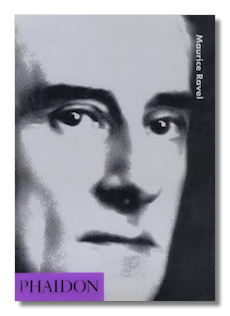
The Internet's Premier Classical Music Source
Related Links
-
Introduction
Acoustics
Ballet
Biographies
Chamber Music
Composers & Composition
Conducting
Criticism & Commentary
Discographies & CD Guides
Fiction
History
Humor
Illustrations & Photos
Instrumental
Lieder
Music Appreciation
Music Education
Music Industry
Music and the Mind
Opera
Orchestration
Reference Works
Scores
Thematic Indices
Theory & Analysis
Vocal Technique
Search Amazon
Recommended Links
Site News
 Book Review
Book Review
Maurice Ravel

Gerald Larner
London: Phaidon Press, Ltd. 1996
ISBN-10: 0714832707
ISBN-13: 9780714832708
Summary for the Busy Executive: Not bad.
Academics have sniffed at this biography as musically superficial because it doesn't have any musical type in it. Apparently, no one has told them that most people don't read music. The book aims squarely at the intelligent general reader.
I like the fact that Larner emphasizes that Ravel was a composer. This sounds obvious, but the number of composer biographies which ignore that basic fact would amaze you. Indeed, many composers' lives and personalities aren't much to write about. They spend most of their day writing music or thinking about writing music. Therefore, authors probably should focus on that music. Larner does this and thus wins from me all kinds of points. He covers most of Ravel's output, major and minor, in a general way, noting the circumstances of composition and the general character of each piece. If you want deep appreciations and insights into Ravel's music, look elsewhere, although Larner I believe remains true to the spirit of each work.
Larner shines, however, in his consideration of Ravel's difficult, enigmatic personality. Many recent Ravel bios have speculated about his sexual orientation (see my review of Benjamin Ivry's Maurice Ravel: A Life, for example) as if, first, they knew it and, second, it shaped his art. Most of them do little more than beg the questions. Ravel gripped the secrets of his personal life very tightly indeed. One finds conflicting testimony about his sexual orientation. Poulenc, certainly in a position to know and to invite confidences, was of the opinion that Ravel was asexual, at least from the point that Poulenc knew him (Ravel in his late forties or early fifties). However, almost everyone agrees that he had no lasting romantic attachment, if any. Furthermore, I know some people claim the ability to discern gay art – a kind of aesthetic gaydar that gives them the ability to know the orientation of an artist without knowing anything of the life – and at one time, I thought I had that magical ability, when I was young and stupid. Consequently, I made hilarious mistakes. Debussy, of course, was gay (all those perfumed breezes!), while Copland was straight as a ramrod (an unfortunate image, as it turns out). Eventually, as I learned more and read more, I came to understand that sexual preference does not necessarily determine the direction of one's art or, indeed, of one's life. Tchaikovsky, after all, thought of himself not as a gay composer, but as a Russian one. Make no mistake, however, it makes little difference to me whether Ravel preferred men to women or vice versa. I'm interested almost exclusively in the music he wrote and in a rounded portrait of his personality.
In addition to the usual Basque and Spanish elements, Larner emphasizes the modernity of Ravel's music. Ravel's father, an engineer, took his son to see his factories, and the boy fell in love with the sound of machinery and with precision craftsmanship. While his music seldom becomes as percussive as, say, Mossolov's Steel Foundry, machines flit through many of his scores like ghosts. One thinks of the clock-shop opening of L' Heure espagnole. Even the snare-drum rhythm in Boléro Ravel himself associated with a factory, and the driving finale of the G-major piano concerto sounds like factory noises sublimated.
Ravel fashioned his music from many sources: Chabrier, Fauré, Debussy (the influence here was mutual), Les Six, Stravinsky, and Schoenberg (particularly Pierrot lunaire) among them. His basic method came down to pastiche, and paradoxically he was never more himself than when he was imitating – a style, a genre, etc. He worked slowly, as essentially a miniaturist. Not one of his scores lasts longer than an hour. In addition, long dry spells afflicted him most of his life. His sonata for violin and cello, a neglected masterpiece, took him eighteen months to complete. Yet he never doubted his calling, and he managed to write large, substantial scores.
Larner gives you the broad outlines of Ravel's music and a balanced idea of his personality. He examines the evidence on the composer's sexual orientation and, like almost every researcher before him, concludes that he hasn't enough to go on. He makes a stronger case for Ravel as the adored child who never grew up – self-absorbed to the point of narcissism, emotionally stunted in his life, though not in his art. He also examines Ravel's troubled last years in detail. When I was young, the standard story on Ravel was that he went insane. Larner makes a case for the composer as having suffered a brain injury from a taxicab accident. The injury took time to manifest itself. Eventually, Ravel developed aphasia and lost his hand coordination to the extent that he could no longer write music. In short, he was probably no crazier than he ever was. For me, this book constitutes a good introduction to Ravel for the general reader.
Copyright © 2008 by Steve Schwartz.


















